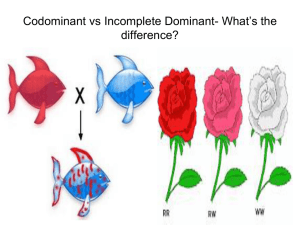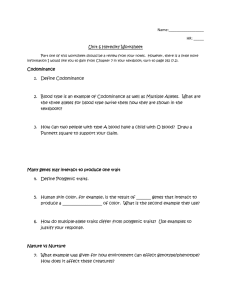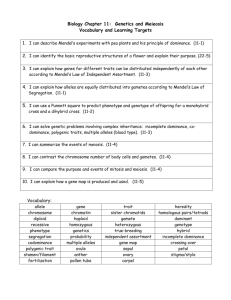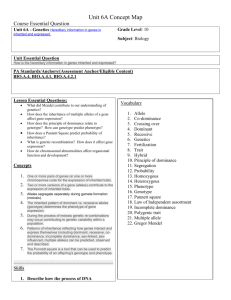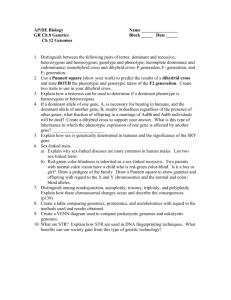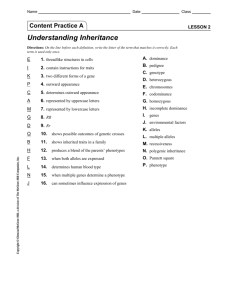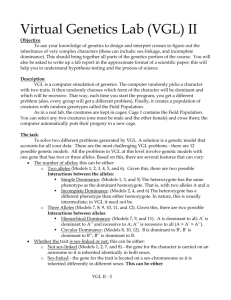Abbreviated Instructions for using BioQUEST
advertisement
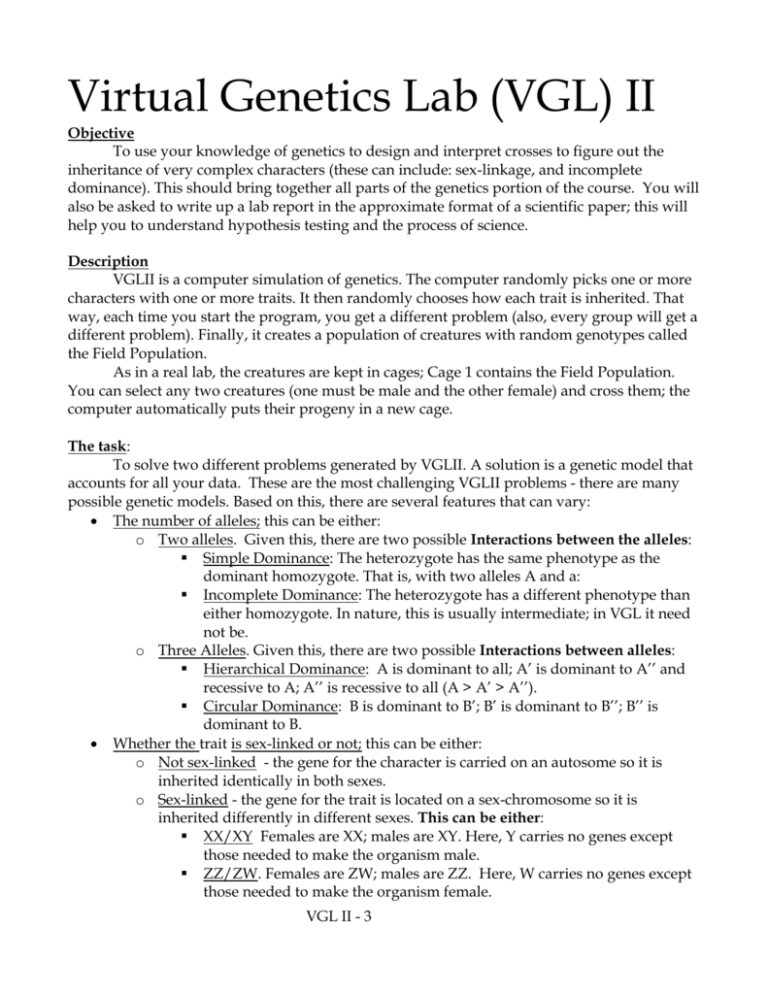
Virtual Genetics Lab (VGL) II Objective To use your knowledge of genetics to design and interpret crosses to figure out the inheritance of very complex characters (these can include: sex-linkage, and incomplete dominance). This should bring together all parts of the genetics portion of the course. You will also be asked to write up a lab report in the approximate format of a scientific paper; this will help you to understand hypothesis testing and the process of science. Description VGLII is a computer simulation of genetics. The computer randomly picks one or more characters with one or more traits. It then randomly chooses how each trait is inherited. That way, each time you start the program, you get a different problem (also, every group will get a different problem). Finally, it creates a population of creatures with random genotypes called the Field Population. As in a real lab, the creatures are kept in cages; Cage 1 contains the Field Population. You can select any two creatures (one must be male and the other female) and cross them; the computer automatically puts their progeny in a new cage. The task: To solve two different problems generated by VGLII. A solution is a genetic model that accounts for all your data. These are the most challenging VGLII problems - there are many possible genetic models. Based on this, there are several features that can vary: The number of alleles; this can be either: o Two alleles. Given this, there are two possible Interactions between the alleles: Simple Dominance: The heterozygote has the same phenotype as the dominant homozygote. That is, with two alleles A and a: Incomplete Dominance: The heterozygote has a different phenotype than either homozygote. In nature, this is usually intermediate; in VGL it need not be. o Three Alleles. Given this, there are two possible Interactions between alleles: Hierarchical Dominance: A is dominant to all; A’ is dominant to A’’ and recessive to A; A’’ is recessive to all (A > A’ > A’’). Circular Dominance: B is dominant to B’; B’ is dominant to B’’; B’’ is dominant to B. Whether the trait is sex-linked or not; this can be either: o Not sex-linked - the gene for the character is carried on an autosome so it is inherited identically in both sexes. o Sex-linked - the gene for the trait is located on a sex-chromosome so it is inherited differently in different sexes. This can be either: XX/XY Females are XX; males are XY. Here, Y carries no genes except those needed to make the organism male. ZZ/ZW. Females are ZW; males are ZZ. Here, W carries no genes except those needed to make the organism female. VGL II - 3 VGL II - 4 The range of problems that VGLII can generate is constrained by the problem file. These are listed below: Level01.pr2: One Autosomal Gene; 2 Alleles, Simple Dominance Level02.pr2: One Autosomal Gene; 2 Alleles, Incomplete Dominance Level03.pr2: One XX/XY Sex-linked Gene; 2 Alleles, Simple Dominance Level04.pr2: One XX/XY Sex-linked Gene; 2 Alleles, Incomplete Dominance Level05.pr2: One Gene (Autosomal or XX/XY Sex-Linked); 2 Alleles, Simple Dominance Level06.pr2: One Gene (Autosomal or XX/XY Sex-Linked); 2 Alleles, Incomplete Dominance Level07.pr2: One Gene (Autosomal or XX/XY Sex-Linked); 3 Alleles, (Incomplete, Hierarchical, or Circular dominance) Level08.pr2: One Gene (Autosomal, XX/XY Sex-Linked, ZZ/ZW Sex-Linked); (2 or 3 Alleles), (Incomplete, Hierarchical, or Circular dominance) Level09.pr2: Two Unlinked Autosomal Genes; 2 Alleles each, Simple Dominance Level10.pr2: Two Linked Autosomal Genes (0.1 < rf < 0.3); 2 Alleles each, Simple Dominance Level11.pr2: Two Genes, either XX/XY Sex-Linked or Autosomal; 2 Alleles each, Simple dominance Level11-1.pr2: Two Genes, either XX/XY Sex-Linked or Autosomal; 2 Alleles each, Simple dominance or Incomplete Dominance Level12.pr2: Three Linked Autosomal Genes (0.1 < rf < 0.3); 2 Alleles each, Simple dominance Level13.pr2: Three Sex-Linked Genes (0.1 < rf < 0.3); 2 Alleles each, Simple dominance Files with names like Level01p.pr2 create the same level of problems as Level01.pr2, but allow practice mode. Your instructor will tell you which level problem you should work for this lab. Your task is to find the genetic model that best fits your data. You should know that, since VGL selects traits randomly, the particular traits do not necessarily indicate the dominance relationships. That is, although you might expect otherwise, having no antennae may be dominant to having antennae. Similarly, having 4 legs may not be the heterozygote of 2-legs and 6-legs. VGL II - 5 Starting up VGLII: 1) You will work in groups of three people per computer. You may want to take turns using the computer. It is easy to fill the screen with cages of creatures and get totally confused so you should work slowly and deliberately and keep careful notes about the experiments you do and the contents of each cage. If you get very confused, you can quit the program and start fresh with a new problem. 2) The program runs on all of the computers in the lab. You can also download the program and run it from your home computer; go to http://intro.bio.umb.edu/VGL/index.htm 3) To run the VGLII program, click on the VGL icon. It looks like a small fly-like insect. 4) If you want to read the VGL manual, click on the Help button at the top of the VGL window. 5) You should choose a problem at the level that your instructor has specified. 6) The objective is to make a genetic model to explain the inheritance of the traits you are studying. There is no way to find the “right answer”; you decide whether you’re convinced or not. A complete model would look like: “The shape of the thorax is controlled by one gene with two alleles: T - tetraltera (dominant) t - grooveless (recessive)” or: “In this creature, XX are female; XY are male. The color of the eyes is controlled by one gene, located on the X-chromosome with 2 alleles: XB - black (dominant) Xb - blue (recessive) Y - no contribution to phenotype” 7) Once you and your partners are convinced of your model, you will then present it to your TA for review. Your TA will then perform a cross with your creatures to test your model. You must do this until you have solved one sex-linked and one non-sex-linked problem. 8) Finally, you must solve one more problem for your Lab Report. We strongly advise you to work through this problem in lab, rather than at home. In lab, your TA can help you to make sure that you have worked it through completely. In addition, although you can run VGLII on your home computer, there is no guarantee that this will work as well as it does in lab. VGL II - 6 9) You should also take careful notes of your results or print your data (Choose “Print Work” from the “File” menu). Lab report: It is very important that you follow all of the directions for preparing your lab report in order to receive full credit. Feel free to contact your TA in advance of the due date if you have any questions. Overall notes Your lab report is due at the start of lab on the date listed in the syllabus. It will not be accepted late. Although you and your group members worked on the same problem, your lab report must be in your own words. Your lab report must be typed; handwritten lab reports will not be accepted. Special note for this lab The lab report must be in the format described below including titles for each section (Abstract, etc.). Lab reports that are not in this format will receive an automatic deduction of 10 points. Parts of the Lab Report This will be structured like a scientific paper to introduce you to this important format as well as the aspects of the nature of science that it illustrates. The most important thing to keep in mind is that a scientific paper is not the story of what you did. It is a logical argument in a prescribed format designed to convince your reader that your conclusions are correct. The most crucial issue is making a clear and logical argument that is supported by data. This means that, in most cases, you will not present your data in the order that you got it; you should present it in a way that makes the clearest case for your interpretation. These are the remaining parts of the lab report. Descriptions in italics indicate their role in the argument you are developing. (5 points) Abstract A 1-3 sentence description of the genetic model that explains the inheritance of your trait. This introduces your reader to the model you are going to be arguing for. (5 points) Introduction A short paragraph that explains the research question being addressed (the inheritance of your trait) and why the methodology being used (crossing individual organisms and looking at the offspring) is believed to be able to answer that question. This introduces the background behind your studies and why they are worth reading about. (5 points) Materials and Methods A short paragraph that explains what you did. Do not give the details of all the crosses you did. All you need here is a few sentence summary of: how many crosses you did; roughly how many of those were necessary to figure out the model; and any strategies you used in choosing what to cross (just VGL II - 7 describe these in general do not talk about each and every cross in detail). This tells the reader the details of the techniques you used. (25 points) Results and Discussion This is the most important part of the paper. It is where you make the argument for your interpretation of the data. Start by introducing the genetic model you have found and defining appropriate symbols (5 points). Then go point-bypoint to show the evidence for your model. This is not a narrative or a history, it is a logical argument supported by data. Do not present all your crosses in the order you did them; present them in the order that makes the clearest argument for the model you described in the Abstract. It is probably best to break this down into parts. For each part of your model, give the evidence for that part. For example, if you want to argue that red eyes are XX/XY sex-linked dominant, you would have separate arguments to show that it is (1) XX/XY sex-linked and (2) dominant. In addition to the 5 points for defining the symbols, we will grade this part using the following rubric: o All parts of model are supported (0 - 8 points). All parts of the model you presented are specifically supported by one or more pieces of data. Less than full credit will be given for answers that do not support all parts of your model. That is, if you say it is “ZZ/ZW sex-linked incomplete dominant”, you have to show data that it is ZZ/ZW, sex-linked, and incomplete dominant. o Data rule out all possible alternative models (0 - 6 points). You present data that specifically exclude all relevant alternative models. Less than full credit if other interpretations are possible. That is, if you choose the above model, you would have to show that it cannot be autosomal, XX/XY sex-linked, circular dominance, etc. By “relevant alternative models”, we mean that, (for example) if you have shown that it must be 3 alleles, you only need to distinguish between incomplete, circular, and hierarchical dominance. o Only relevant data are presented (0 - 6 points). All pieces of data presented are part of an explicit argument that supports the selected model or rules out other models. Less than full credit for data presented that are not part of your argument. VGL II - 8

